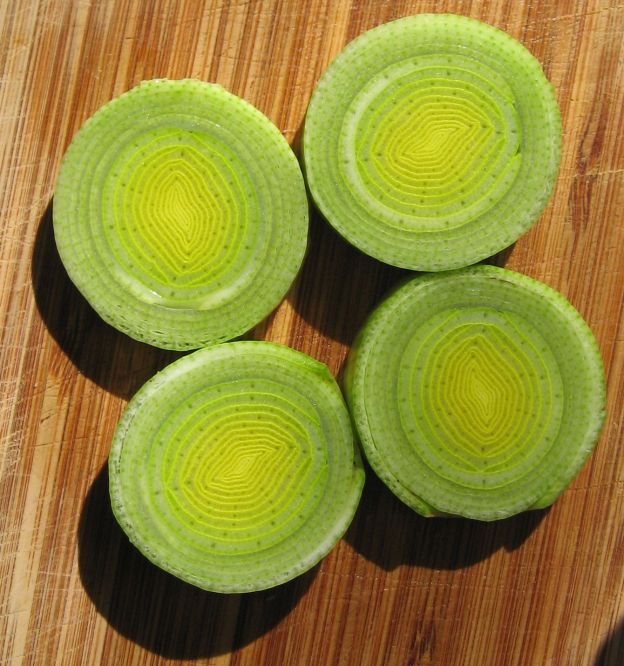FLUELLEN …and I do believe your majesty takes no scorn to wear the leek upon Saint Tavy’s day.
KING HENRY V I wear it for a memorable honour; For I am Welsh, you know, good countryman.
Shakespeare, Henry V, act 4, scene 7
Break out the daffodils and leeks! This past Friday, March 1, was St. David’s Day, the feast day of the patron saint of Wales and a national holiday in that country. As long as you are cleaning and slicing leeks, let’s take a quick close look at the vegetable, one of the national symbols of Wales.
Leeks, along with onions and garlic, are in the genus Allium in the family Amaryllidaceae. Like many other monocots, they have long slender leaves striped with parallel veins. Also common in monocots, and sometimes confusing, is the way their leaves develop. The white part of a leek looks like a big solid cylinder composed of concentric leaf tubes, and essentially it is. Each new leaf develops at the center of the cylinder in the form of a tube that surrounds the next little mound of tissue that will develop into a leaf. This is easy to see if you slice the root end of the leek in half as close to the center as possible and examine the innermost leaves. In mature leaves, the top part of the tube opens up into a flat green blade.
The pattern of leaves enclosing leaves at the base is evident in many monocot houseplants, such as peace lilies and orchids. It is also easy to see in corn plants as well as onions and garlic.
One of the most fun aspects of leek morphology, however, is their contractile roots. Look closely at the roots, and you will see that many are ribbed horizontally like a pushed-up sleeve or a tubular accordion. Such ribbed roots have already done their job, contracting to pull the plant down deeper into the soil. No wonder those resourceful leeks were chosen as a national symbol. As Fluellen says later on in the play, “Ay, leeks is good.”
If you have any leftover leeks, please save them for our post on potato leek soup.


Ay leeks ARE good as is your column. Look forward to each one. Thanks!
LikeLike
Check out how a banana “tree’s” “stem” is constructed; a 2.5-3 m tube of concentrically overlapping leaf bases.
LikeLike
Pingback: NIbbles: Perennial grains, @gr0b10d1v3r$1ty, Games, Leeks, Millets in Rome, Insectivory
You can’t beat cawl cennin (leek soup)
LikeLike
Pingback: Crop of the month: Leek | Science on the Land
Pingback: A very close look at potato leek soup | The Botanist in the Kitchen
Pingback: Greens: why we eat the leaves that we do | The Botanist in the Kitchen
Pingback: The Extreme Monocots | The Botanist in the Kitchen
Pingback: Alliums, Brimstone Tart, and the raison d’etre of spices | The Botanist in the Kitchen
Pingback: The Botanist in the Root Cellar | The Botanist in the Kitchen